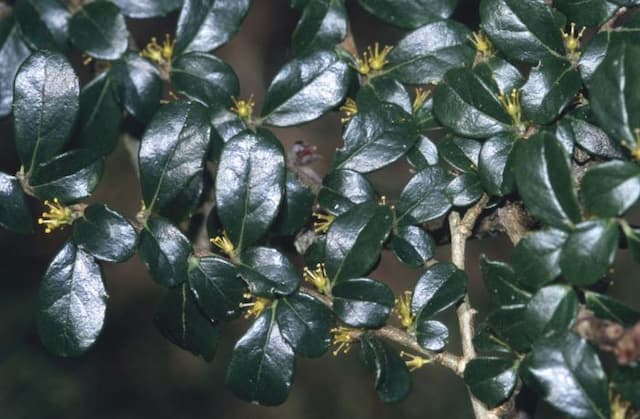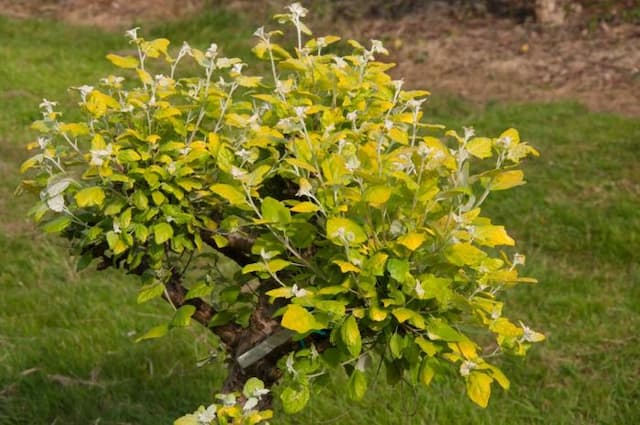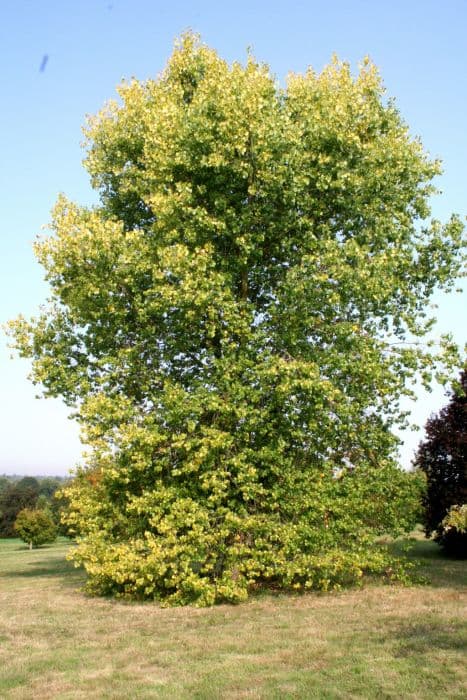Oppositeleaf Willow Salix subopposita

ABOUT
Salix subopposita, commonly known as the opposite-leaved willow, is characterized by its slender branches and narrow leaves. The leaves of this willow are distinctive due to their arrangement on the stems; they are often placed nearly opposite each other, which is a rare trait among willow species. The foliage is typically green, and the leaves may have a slightly serrated edge, giving them a delicate texture. During the blooming period, the opposite-leaved willow produces catkins, which are cylindrical flower clusters that can be either male or female, depending on the individual tree. These catkins appear before the leaves fully develop and are often silvery or yellowish in color. The bark of the opposite-leaved willow is generally smooth with a greyish or brownish tint and may develop furrows as the plant matures. The overall form of the opposite-leaved willow is graceful, with branches that may droop elegantly, adding to its ornamental appeal.
About this plant
 Names
NamesFamily
Salicaceae
Synonyms
Manchurian Willow, Subopposite Willow
Common names
Salix subopposita.
 Toxicity
ToxicityTo humans
Salix subopposita, commonly known as the shrubby willow, is not typically recognized for being toxic to humans. But, as with many willows, it may contain salicin, a chemical that can be converted into salicylic acid in the body. Salicylic acid is the active component in aspirin and can cause toxicity if consumed in large quantities. However, standard interaction or casual ingestion of parts of shrubby willow likely wouldn’t result in adverse effects. Excessive intake might lead to symptoms similar to aspirin overdose, which include nausea, vomiting, diarrhea, headache, dizziness, tinnitus, and confusion. In severe cases, more serious effects such as breathing difficulties, seizures, and coma could occur due to metabolic acidosis or respiratory alkalosis. It is essential to use caution and consult with a medical professional if any part of a plant is ingested in substantial amounts or if adverse reactions are observed.
To pets
Salix subopposita, known as the shrubby willow, is not commonly known to be toxic to pets. Willow species may have varying levels of salicin, which can be metabolized into salicylic acid, the basis for aspirin. While salicin itself is not usually highly toxic, ingestion in considerable amounts could potentially cause stomach upset or more serious effects similar to aspirin toxicity, such as gastrointestinal irritation, ulcers, vomiting, diarrhea, and potentially more serious complications in more sensitive individuals or in cases of significant ingestion. Pets with known health issues or those under medication that could interact with salicylic acid should be kept from ingesting shrubby willow. If you suspect your pet has ingested a large amount of shrubby willow and is showing symptoms of distress, you should contact a veterinarian.
 Characteristics
CharacteristicsLife cycle
Perennials
Foliage type
Deciduous
Color of leaves
Green
Height
6-10 feet (1.8-3 meters)
Spread
4-8 feet (1.2-2.4 meters)
Plant type
Shrub
Hardiness zones
4
Native area
Japan
Benefits
 General Benefits
General Benefits- Erosion Control: Salix subopposita, commonly known as the violet willow, has extensive root systems that stabilize soil and prevent erosion.
- Habitat Creation: The violet willow provides habitat and nesting sites for various bird species, insects, and other wildlife.
- Ornamental Value: With its attractive foliage and form, the violet willow can be used for landscape beautification.
- Shade Provision: The tree can offer shade in gardens and parks, making outdoor spaces more comfortable in hot weather.
- Windbreak: The violet willow can act as a windbreak, offering protection against strong winds for crops and buildings.
 Medical Properties
Medical Properties- Anti-inflammatory: Salix subopposita may contain salicin, a compound known for its anti-inflammatory properties, which could be useful in reducing inflammation in various conditions.
- Analgesic: The presence of salicin can also provide pain-relieving effects, making the plant potentially useful for addressing discomfort associated with aches and pains.
- Antipyretic: Salix subopposita may help reduce fever due to the salicin content, which is a precursor to aspirin and has fever-reducing capabilities.
- Antirheumatic: The salicin in Salix subopposita can potentially be used to treat rheumatic pain, offering relief from joint and muscular pain associated with rheumatic conditions.
 Air-purifying Qualities
Air-purifying QualitiesThis plant is not specifically known for air purifying qualities.
 Other Uses
Other Uses- Salix subopposita, commonly known as Dwarf Arctic Willow, can be used in miniature bonsai practices due to its small size and attractive growth form.
- Due to its hardy nature, the Dwarf Arctic Willow is ideal for use in erosion control projects in cold climates where other plants might not thrive.
- The flexible branches of the Dwarf Arctic Willow can be woven into baskets and other traditional handicrafts.
- This plant can be used as a natural dye source; the bark contains tannins that produce a range of colors when used in fabric dyeing.
- Dwarf Arctic Willow is often planted as a windbreak to protect more delicate garden plants from strong winds.
- The fibrous roots of the Dwarf Arctic Willow make it useful for stabilizing stream banks and preventing soil erosion in riparian zones.
- Landscapers use this plant for creating textured groundcovers in rock gardens, where it adds visual interest with its silver-green foliage.
- In colder regions, the Dwarf Arctic Willow serves as a robust pioneer species that facilitates the establishment of subsequent plant communities in disturbed areas.
- Its tolerance for high moisture levels makes it suitable for planting in rain gardens, which help in mitigating runoff and improving water quality.
- Its dense growth habit provides refuge and nesting sites for various small bird species in its native habitat.
Interesting Facts
 Feng Shui
Feng ShuiThe plant Salix subopposita, commonly known as 'Dwarf Willow,' is not used in Feng Shui practice.
 Zodiac Sign Compitability
Zodiac Sign CompitabilityThe Dwarf Willow is not used in astrology practice.
 Plant Symbolism
Plant Symbolism- Resilience: Salix subopposita, also known as Willow, often symbolizes resilience due to its ability to bend without breaking and to grow back even when cut down.
- Flexibility: The pliant branches of the Willow tree highlight the quality of flexibility, encouraging adaptability to life's changes and circumstances.
- Grieving and Healing: In some cultures, the Willow is associated with mourning due to its drooping appearance, but it also represents the healing process and the journey toward recovery.
- Wisdom: Ancient traditions often connect the Willow with wisdom and knowledge, possibly because of its long lifespan and its presence near water, which is often seen as a symbol of insight.
- Protection: Historically, the Willow has been seen as a tree that offers protection, with people using its branches and leaves for shelter and even in spiritual or magical practices to ward off evil.
 Water
WaterThe Opposite-leaved Willow (Salix subopposita) thrives in consistently moist soil and should be watered deeply when the top inch of soil feels dry to the touch. During the growing season, this might mean watering approximately every 5 to 7 days, depending on weather conditions. Aim to provide about 1 to 1.5 gallons of water each time to ensure the root zone is thoroughly moistened. In the fall and winter, reduce watering frequency as the plant goes dormant and requires less moisture. Always ensure that the planting site has good drainage to prevent waterlogging.
 Light
LightThe Opposite-leaved Willow prefers full sun to partial shade. It thrives in a location that receives at least four hours of direct sunlight daily, but it also tolerates some light shade, especially in hotter climates. Avoid deeply shaded areas as this can lead to poor growth and fewer leaves.
 Temperature
TemperatureThe Opposite-leaved Willow is hardy and can tolerate a range of temperatures. It can survive minimum temperatures down to around -20 degrees Fahrenheit and maximum temperatures well into the 90s Fahrenheit. However, the ideal temperature range for optimal growth is between 50 and 75 degrees Fahrenheit.
 Pruning
PruningPrune the Opposite-leaved Willow during the dormant season, in late winter or early spring before new growth emerges. Pruning is necessary to remove dead or damaged branches, promote a desired shape, and encourage more vigorous growth. Cut back any overgrown branches or parts that interfere with the plant's structure, but avoid heavy pruning which can stress the plant.
 Cleaning
CleaningAs needed
 Soil
SoilThe Manchurian Willow prefers consistently moist, well-draining soil. A mix of peat, loam, and sand can provide the ideal texture, ensuring adequate drainage and moisture retention. The soil pH should be acidic to slightly alkaline, ranging from 6.0 to 7.5, to support healthy growth.
 Repotting
RepottingThe Manchurian Willow should be repotted every 2 to 3 years to refresh the soil and allow room for growth. Younger willows may require more frequent repotting due to their faster growth rate, whereas mature plants can be repotted less often.
 Humidity & Misting
Humidity & MistingThe Manchurian Willow thrives in moderate to high humidity. To maintain optimal health, aim for a humidity level around 60-80%. This mimics the willow's natural moist habitat, although it can tolerate lower levels without significant harm.
 Suitable locations
Suitable locationsIndoor
Provide bright light, keep moist, and use humidifier.
Outdoor
Full sun, moist soil, protect from harsh winds.
Hardiness zone
4-8 USDA
 Life cycle
Life cycleSalix subopposita, commonly known as the Subopposite Willow, begins its life cycle as a seed which germinates in moist soil conditions during spring. After germination, it quickly develops a root system and a shoot that grows into a sapling. As a fast-growing willow species, it progresses from a sapling to a mature tree within a few years, characterized by its slender branches and elongated leaves. The Subopposite Willow is dioecious, producing either male or female flowers on separate trees; the flowers, known as catkins, emerge in early spring before the leaves fully develop. Once pollinated, usually by wind or insects, the female catkins produce tiny seeds encased in cottony tufts that are dispersed by wind and water. The mature tree continues to grow and can reproduce annually through both seeds and vegetatively by rooting branch cuttings, with a typical lifespan of several decades depending on environmental conditions.
 Propogation
PropogationPropogation time
Spring to Summer
Salix subopposita, commonly known as the Dwarf Arctic Willow, is typically propagated using the method of stem cuttings. This is the most popular method because it's efficient and leads to quicker establishment of the plant. To propagate the Dwarf Arctic Willow via stem cuttings, one would cut a length of new growth from a healthy plant, usually about 6 to 8 inches (15 to 20 centimeters) long. The best time to do this is in the late winter to early spring, just before the growing season begins. The cutting should include at least a couple of nodes, which are the points on the stem where leaves are attached. These nodes are where new roots will sprout from when placed in the proper growing medium. It's important to plant the cutting in moist soil or a potting mix and keep it well-watered until it establishes a robust root system.









